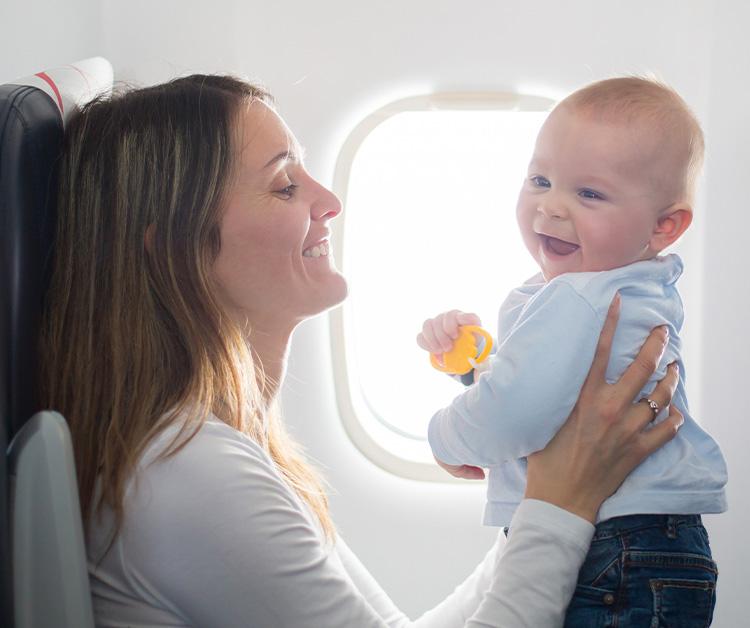Due to maintenance, rewards points for receipt uploads will be delayed. Thank you for your patience!

Everything you need to know about flying with your baby.
Whether you're a first-time parent or a seasoned traveler, navigating the skies with a baby gets a lot easier with thoughtful planning and preparation. In this guide, we'll explore essential tips for flying with an infant, discuss age considerations, provide a checklist of must-haves, and offer creative solutions for keeping your baby entertained during the flight.
Ensure that you have enough formula or breast milk for the entire flight, taking into account potential delays. If you’re using a ready-to-use formula, it can help to purchase smaller containers to make on-the-go storage easier.
Accidents happen, and it's better to be over-prepared. Pack more diapers and wipes than you think you'll need, and have a changing pad for in-flight diaper changes.
Ideally there might be flights that align with your baby's nap schedule. A well-rested baby is more likely to be calm and content during the journey.
There’s going to be a lot of stimulation and new experiences for your little one, and every baby will respond differently to that environment. The best thing you can do is to create comfort for your baby with fun and games. Bring your baby's favorite blanket, stuffed animal, or pacifier with you, and if you can, give yourself as much time as possible to get to the airport so that you don’t have to feel rushed. Your baby will likely respond to your cues, and your calmness can help them feel at ease.
Understand the specific policies of the airline you're flying with regarding baby amenities, such as bassinets, baby food, and stroller check-in.
Sometimes cabin pressure changes during takeoff and landing can hurt your baby’s ears. Generally speaking, children and babies can be more sensitive to these changes in pressure than adults, and while the effects are temporary, it can be unfamiliar and therefore scary for your little one to experience at first. Here are some tips for helping them find relief:
It is generally safe for babies to fly as early as a few days old, but it’s always best to consult with your pediatrician before planning a trip, especially if your baby was born prematurely or has a medical condition. Some airlines may have specific age requirements, so be sure to check their policies before booking.
When traveling with baby formula, you can opt for the convenience of ready-to-use formula–that way you don’t need to worry about measuring and mixing on the go. And for parents looking for hypoallergenic options, there is Nutramigen® Hypoallergenic Infant Formula - Ready to Use, which happens to be the #1 pediatrician recommended formula brand for Cow’s Milk Allergy.
Our Nutramigen infant formula is designed to give nutrition your baby needs for healthy development while helping to provide relief from colic they may be experiencing due to cow’s milk allergy. It’s also lactose-free, and has DHA and ARA, nutrients that are found in breast milk that support baby’s brain and eye development. If you're preparing for a trip, check out our guide on traveling with a baby with a cow milk allergy for tips on making the journey easier.
All the stimulation and new experiences don’t have to be stressful--they can be exciting! Don’t be afraid to show your baby around if they’re excited by all the new things--some little explorers get frustrated if they feel bored or like they’re missing out on the action.
Bring small, quiet toys that capture your baby's attention, like soft rattles or plush books.
Play peek-a-boo, sing nursery rhymes, or engage in other interactive games to keep your baby entertained. If you have a window seat, show your baby the clouds passing by. Sit your baby in your lap and help them pretend they’re flying the plane--there’s all sorts of fun and creative ways to keep them occupied--the sky's the limit!
If it's safe to do so, let your baby explore their surroundings within the confines of your seat area. Show them how the tray table opens and closes. When safe to do so, take a walk around the cabin. Introduce them to the flight attendants--sometimes meeting new people and seeing smiling faces can add to the fun! Just keep an eye out for when your baby might be getting tired or overwhelmed, and have a safe space in your seat where they can relax.
If your baby loves falling asleep in the car, they might also like a flight if it feels like a car ride. If your little one wants to rest, count your lucky stars and let them get that shuteye!
All information on Enfamil, including but not limited to information about health, medical conditions, and nutrition, is intended for your general knowledge and is not a substitute for a healthcare professional's medical identification, advice, or management for specific medical conditions. You should seek medical care and consult your doctor or pediatrician for any specific health or nutrition issues. Never disregard professional medical advice or delay seeking medical treatment, care, or help because of information you have read on Enfamil.